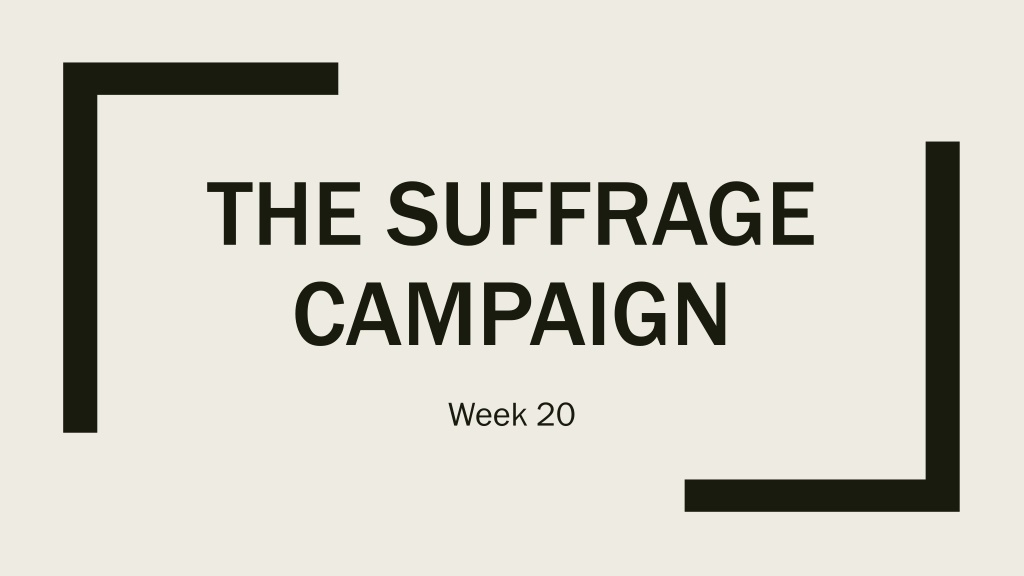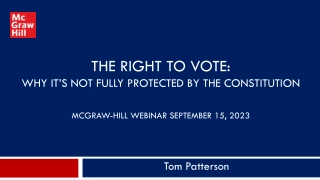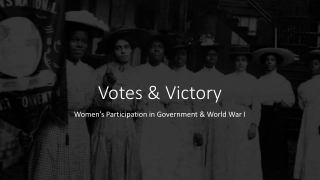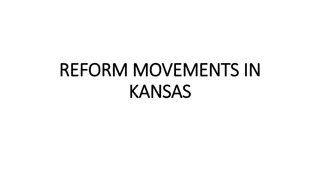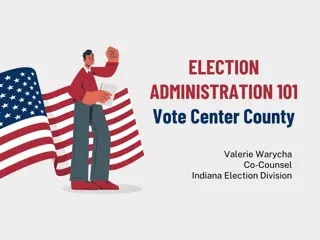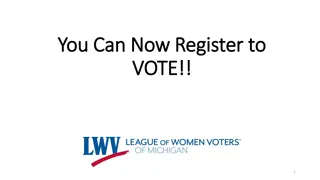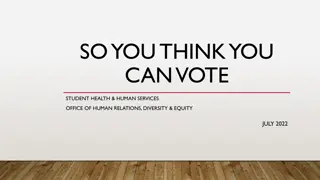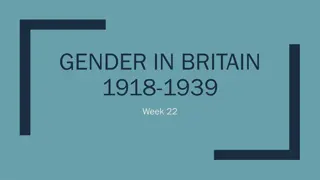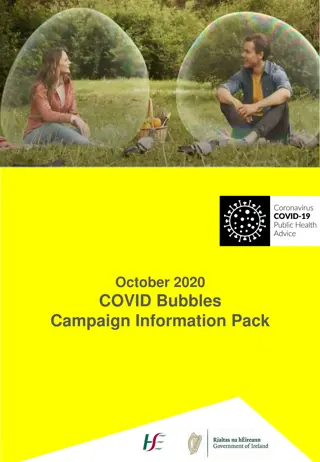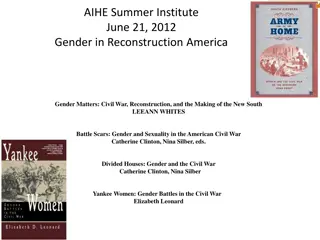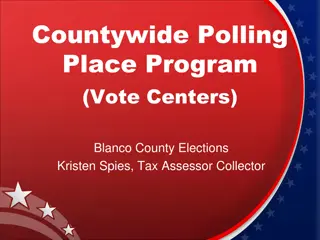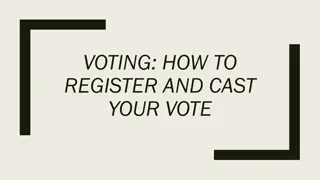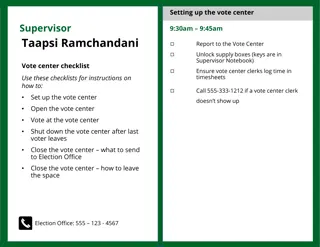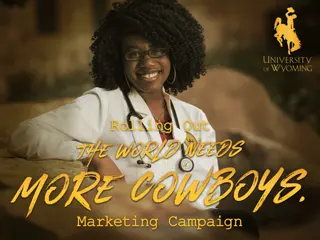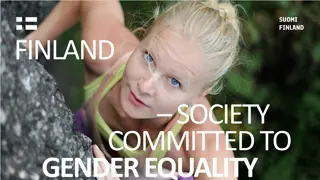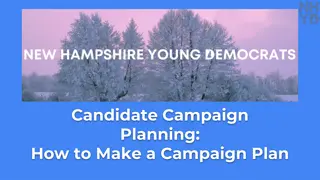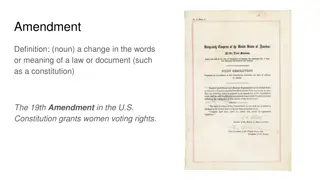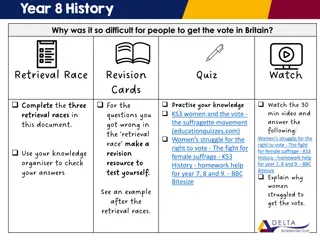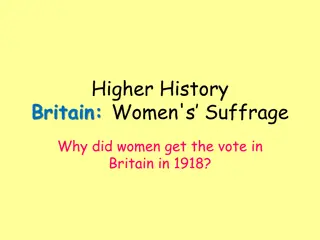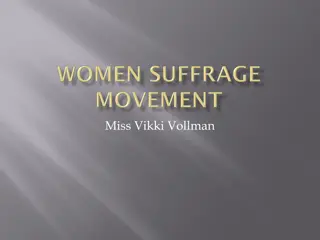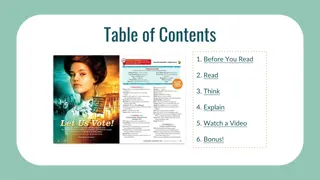The Suffrage Campaign: A Historical Journey Towards Women's Right to Vote
The suffrage campaign traces its origins back to the 19th century, with notable figures like J.S. Mill and Lydia Becker advocating for women's right to vote. The movement saw the formation of official organizations like the London Society for Women's Suffrage and the Manchester Society for Women's Suffrage. Over time, suffragists and suffragettes emerged, with groups like the National Union of Women's Suffrage Societies and the Women's Social and Political Union driving the cause forward. The campaign reinvigorated as public support grew, ultimately leading to significant milestones in the fight for women's suffrage.
Download Presentation

Please find below an Image/Link to download the presentation.
The content on the website is provided AS IS for your information and personal use only. It may not be sold, licensed, or shared on other websites without obtaining consent from the author. Download presentation by click this link. If you encounter any issues during the download, it is possible that the publisher has removed the file from their server.
E N D
Presentation Transcript
THE SUFFRAGE CAMPAIGN Week 20
Overview The early campaign Suffrage reinvigorated Campaign methods Anti Suffragism Men in the suffrage movement Gaining the vote Historiographical debates
19thcentury origins. William Thompson William Thompson, Appeal of One Half of the Human Race, Women, Against the Pretensions of the Other Half, Men, to Retain them in Political, and Hence in Civil and Domestic, Slavery. (1825) Henry Hunt Henry Hunt MP: 1st petition to House of Commons (1832) rejected. Chartists drop female suffrage from final charter. (1830s) Association for Female Franchise est. Sheffield by Anne Knight (1851) Knight persuaded Lord Carlisle to present another petition rejected. 1860s: TURNING POINT
Escalating calls for female suffrage J.S. Mill J.S. Mill inspired by Harriet Taylor of Women (1861) arguing that enslavement of women prohibits progress of mankind. 1867 Reform Act enfranchised more working-class men (and again in 1884) Mill hands petition signed by 1,500 women to the H of C for women to be included fails. Harriet Taylor to write The Subjection
The first official organisations Consequently, organised suffrage campaign starts initially: The London Society for Women s Suffrage and the Manchester Society for Women s Suffrage. London had Mill as president. Most member were law abiding middle-class liberals. Many (including Millicent Garrett Fawcett) on to become Suffragists. Manchester sought to develop nationwide campaign inspired. Lydia Becker Becker did much to inspire this by travelling and speaking up and down the country. The Society had links with the working class and industrial politics of the north. Many(including Pankhurst) went on to become Suffragettes. Millicent Garrett Fawcett) went Lydia
SUFFRAGE REINVIGORATED
Suffrage Reinvigorated: Est WSPU Suffragists: Suffragists: National Union of Women s Suffrage Societies (NUWSS) est. in 1897 led by Fawcett. Suffragettes Suffragettes: break away from NUWSS to form militant Women s Social and Political Union WSPU in 1903. WSPU bring attention, publicity and renewed support which benefitted both organisations. WSPU attract more diverse range of support: Liddington and Norris among 1st to show greater level of working class involvement than previously thought: Annie Kenney and Hannah Mitchell high profile examples.
Suffrage Reinvigorated: ILP However: from 1912 - Labour Party announces support for female suffrage with prominent politicians driving forward call for female suffrage e.g. Kier Hardy Kier Hardy. This caused NUWSS to believe that Labour Party offered best prospect for women s suffrage and formed an influential alliance. Meanwhile, Sylvia Pankhurst Sylvia Pankhurst split from the WSPU, mother and sister to form the East London Federation of Suffragettes (ELF) which was also aligned to the Labour Party.
Methods: WSPU Militancy Perception of division between militant suffragettes and constitutional suffragists. False divide: members belonged to both groups. Definition of militancy fluid: confrontational/ radical/ violent/ assertive/ aggressive. mild militancy starts 1905 with more extreme militancy starting in 1912. Unladylike behaviour attracted public and political attention.
The cause was given its first martyr in 1913 when Emily Wilding Davidson threw herself under the King's horse on Derby Day, 1913. A martyr and hero to some, Emily represented to others why women shouldn t get the vote. If this was what educated women could do what would less educated women be capable of if they did get the franchise?
Methods: National Union of Womens Methods: National Union of Women s Suffrage Societies Suffrage Societies Largest women s suffrage organisation. 1907-1910 number of societies affiliated with NUWSS increased by 400, total membership increased by 50,000. Law abiding methods: lobbying and petitioning government. Publicised activities through official paper the Common Cause. Tactics and work with ILP now recognised key to achieving vote (Jane Robinson). Other go further claiming violence hindered cause (Julia Bush). Severely doubted by some historians who still place emphasis on militancy (Paula Bartley).
ANTI SUFFRAGE CAMPAIGN
Anti suffrage campaign Drew on notions of separate spheres. Most famous anti suffragist was the novelist Mary Humphrey Ward. She supported forward policy which encouraged women s involvement in local politics Women s National Anti-Suffrage League est. in 1908 later joined with the men s league to become the National League for opposing Women s Suffrage. By 1910 they had over 100 branches, 16,000 members and 400,000 signatures on petitions.
Mens arguments for womens exclusion from franchise also drew on women s: lack of common sense tendency to be ruled by emotion or physiological shortcomings due to menstruation or child bearing neglect of the home and children women s questionable mental capacity compared to men.
MEN IN THE SUFFRAGE MOVEMENT
Men in the Suffrage Movement. Female suffrage never exclusively female movement. High profile writers, philosophers, politicians and trade unionists supported cause. Frederick Frederick Pethwick Pethwick Lawrence Lawrence - Liberal candidate who moved to left and WSPU after marrying. William Ball - working class man and trade unionist. Arrested for window smashing in 1911, prisoned with hard labour. Force fed repeatedly and eventually suffered temporary mental breakdown.
Men in the Suffrage Movement Men s organised suffrage groups began to form in the mid 1900 s as auxiliaries to women s suffrage groups. The Men s League for Women s Suffrage formed by a group of largely middle class, left wing radicals (10 branches est. by 1910). This was followed by the Men s Political Union a male wing of the WSPU that carried out militant tactics and acted as WSPU bodyguards. Men s position in the movement was difficult. Most work carried out behind the scenes to avoid usurping or interfering with the women s actions.
Gaining the Vote 1917 Representation of the People Act: only women over the age of 30 were given the vote. This enfranchised some 7 million British women but left another 5 million still without the suffrage. (Equal Franchise in 1928) No celebration as country deep in war. Hard to argue that women s war work resulted in the suffrage as most young, female munitions workers were excluded. Historians now argue the threat of campaigning resuming influenced the all-party committee to include women in the franchise legislation.
Historiography: The debates continue Why did women want the vote? Why didn t women want the vote? Was it a white middle-class movement? Did violence help or hinder the cause? Has the significance of the Pankhurst s been exaggerated? Why were women finally granted the vote? Did the ability to vote make any real difference to women s lives?
Further Reading Joyce Marlow, Suffragettes, (2000) SOURCEBOOK June Purvis/Maroula Joannou, The Women s Suffrage Movement: New Feminist Perspectives (2009) Julia Bush, Women Against the Vote: Female Anti Suffragism in Britain (2007) Diane Atkinson, Rise up Women (2018) Sarah Ridley, Suffragettes and the Fight for the Vote (2018) Melanie Philips, The Ascent Of Woman (2004) Cheryl R. Jorgensen-Earp, Speeches and Trials of the Militant Suffragettes (1999) SOURCEBOOK Harold L Smith, The British Women's Suffrage Campaign (2009)
